The foreseeable future is marked by uncertainty. Economic trends and successive disruptions are reshaping the economy as we know it.
Recent global events have accelerated dynamics long in play and introduced widespread business disruption. While the technological and societal transformations underway are likely positive in the long term, they are also creating demand for new resilience measures.
In times of crisis, more is lost by indecision than by the wrong decision.
But how can you build resilience within your organization? Below, we outline the importance of being resilient and the key steps you can take to enhance your organization’s ability to withstand disruption and thrive in the face of adversity.
Operational Risk and Resilience Teams Need to Balance a Complex Agenda
Now more than ever, resilience is essential. Whether facing a natural disaster, cyber attack or IT outage, or global pandemic, resilient organizations are better equipped to navigate these challenges and emerge stronger. Resilience allows organizations to anticipate, prepare for, respond to, and adapt to both gradual changes and sudden disruptions. However, this also means balancing a complex agenda.
Crisis Management Plans
Addressing the ad hoc shocks of health, information security, third-party, geopolitical, climate, and economic crises is crucial for safeguarding the stability and resilience of businesses and communities. These multifaceted challenges can have profound and far-reaching impacts, disrupting critical operations, compromising data integrity, and threatening livelihoods. Proactively managing these risks by implementing proper crisis management plans is essential to ensuring continuity and resiliency, fostering customer and stakeholder trust, and building a sustainable future amidst an increasingly unpredictable global landscape.
Business As Usual-ish
Companies must be able to run their day-to-day business operations in this complex social and economic environment while remaining prepared to reassess their strategies, processes, and product offerings in response to unforeseen challenges and evolving consumer demands. Implementing flexible work arrangements and investing in technology can empower teams to respond swiftly, ensuring that their organization’s operations remain seamless even amid disruption.
Accelerated Transformation
Organizations today must implement continuity and resilience programs in order to proactively respond to the rapidly shifting needs of customers and the ever-changing operating environment. Being able to adapt to evolving customer needs and the dynamic threat landscape is crucial for maintaining a competitive advantage and driving business growth. By implementing these programs, organizations can enhance their agility, innovate more effectively, and better meet the demands of the market, ensuring long-term success and resilience.
Fusion Helps Organizations Achieve Operational Resilience with Integrated Solutions
Over the span of nearly two decades, Fusion has helped hundreds of global organizations balance a complex agenda, mitigate changing operational risks, and adapt with agility in the face of continuous change.
5 Ways Fusion Mitigates Operational Risks
- Technology Enabled – Fusion amplifies your resilience efforts through insights and workflow automation.
- Best Practices Methodology – Leverage Fusion’s 20 years of experience building resilience with hundreds of the world’s renowned brands.
- Quick Start Templates – Don’t start from zero. Utilize our quick start templates, content, and various other resources to jumpstart your program.
- Integrated with Your Organizational Data – Leverage the great insights you already have through our plug-and-play connectors and integrations.
- Strong Community of Resilience Professionals – Share learnings, challenges, and recommendations with our expert community of resilience leaders and practitioners.
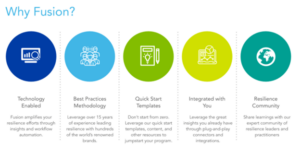
Understanding the Importance of Organizational Resilience
We’ve partnered with many organizations in driving new innovation in resilience aligned to an evolving regulatory perspective and best practices. This shared view of resilience across industries has a renewed focus on the needs of customers, economies, and global markets, as well as the sustained interests of enterprises.
From our findings over the years, we have developed 10 Steps to Get Started With Operational Resilience, a quick guide to help you learn how to leverage agile, collaborative risk and resilience strategies to boost your company’s recovery plans.
What Tools Can Help in Building Organizational Resilience?
Building resilience is not something you can do manually; it requires the right tools, resources, and technologies. Fusion’s operational resilience software offers a comprehensive solution for managing risk, improving cumbersome processes, and ensuring business continuity.
With Fusion, you gain a holistic view of your organization’s operations, allowing you to monitor risks in real time and make informed, data-backed decisions to protect your critical services. Our platform’s robust capabilities enable you to identify vulnerabilities, assess the impact of potential disruptions, and implement effective strategies to enhance your organization’s resilience posture.
Key Benefits of Fusion’s Operational Resilience Platform
- Real-time Risk Monitoring: Stay ahead of potential threats with real-time insights into your organization’s risks.
- Comprehensive Service Mapping: Gain a clear understanding of how your critical services are delivered and where potential failures may occur.
- Impact Assessments: Evaluate the potential impact of disruptions and develop strategies to mitigate risks.
- Continuous Improvement: Use data-driven insights to continuously improve your processes and build long-term resilience.
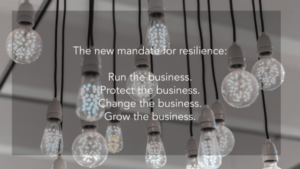
These benefits and integrated view of resilience help organizations surmount sustained external and internal pressures in a new era of transformation. Fusion gives organizations an inherent understanding of how their business works, how it breaks, and how to put it back together again (and how to do so in new and effective ways).
5 Key Activities to Establish a Strong Operational Resilience Program
When building a resilient enterprise, financial services regulators and leading firms are establishing a new foundation for operational resilience through the following key activities:
- Service Identification – Identify your critical or important business services.
- Resource Mapping – Map your resources to your critical or important business services.
- Impact Tolerances – Set defensible impact tolerances; do this by reviewing your methodologies to ensure that the impact tolerances that you’re establishing are realistic.
- Scenario Testing – Validate and challenge the impact tolerances that you’ve set as well as the current state of your service resiliency.
- Response/Communication – Determine where to invest your time and resources to improve the current state of your service recovery; ask yourself: “How do we need to adjust our current contingency strategies in order to align with our services?”
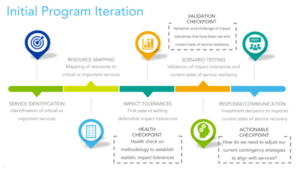
Bolster Your Operational Resilience Posture with Scalable and Actionable Strategies
Fusion’s operational resilience capabilities extend your existing program by creating connected experiences for companies that allow them to make their initiatives actionable and scalable.
The key steps necessary to enhance organizational resilience include:
- Catalog Customer-Facing Services: Understanding Your Critical Operations
The first step in building resilience is to identify and document all of your customer-facing services. These services are the lifeblood of your organization, and any disruption can have significant consequences. Start by cataloging every service that directly impacts your customers. This includes understanding what these services are, how they are delivered, and their importance to your customer base. The goal is to have a clear and comprehensive list of all critical operations so that you can prioritize them in your resilience planning.
Key Questions:
- Which services are most critical to our customers?
- How do these services impact customer satisfaction and loyalty?
- What are the potential risks if these services are disrupted?
- Assess the Importance of Critical Services: Prioritizing Resilience Efforts
Once you’ve identified your critical services, the next step is to assess their importance from multiple perspectives: customer, economic, and market. Understanding the significance of each service allows you to prioritize your resilience efforts. Not all services are created equal; some may have a greater impact on your organization’s bottom line or reputation. By evaluating these services through different lenses, you can allocate resources more effectively and focus on protecting what matters most.
Key Questions:
- What is the financial impact of each service?
- How do these services contribute to our competitive advantage?
- What are the potential long-term consequences of a service disruption?
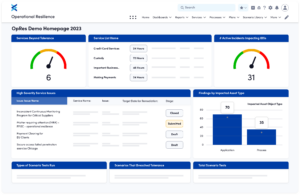
- Map Service Delivery: Identifying Potential Points of Failure
Mapping the entire process of delivering your critical services is essential for identifying potential points of failure. This involves a detailed analysis of each step in the service delivery process, from start to finish. By understanding how each service is delivered, you can pinpoint where disruptions are most likely to occur and develop strategies to mitigate those risks. This step is crucial for ensuring that your organization can continue to deliver essential services, even in the face of adversity.
Key Questions:
- What are the steps involved in delivering each service?
- Where are the potential bottlenecks or vulnerabilities?
- How can we improve the efficiency and resilience of our service delivery process?
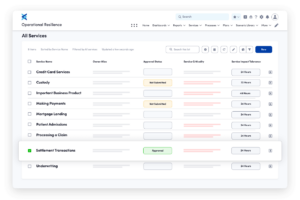
- Evaluate the Impact of Disruptions: Preparing for the Unexpected
No matter how well you plan, disruptions are inevitable. The key is to be prepared for them. Evaluate the potential impact of various disruptions on your critical services and develop contingency plans to manage these risks. This includes assessing the likelihood of different scenarios, understanding how they may impact your business, and developing strategies to minimize the damage. By preparing for the unexpected, you can ensure that your organization is ready to respond quickly and effectively when a crisis occurs.
Key Questions:
- What are the most likely disruptions we could face?
- What is the potential impact of each disruption on our critical services?
- How can we mitigate these risks and ensure business continuity?
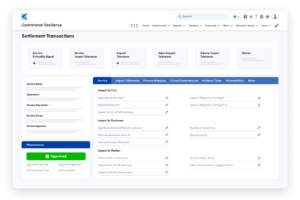
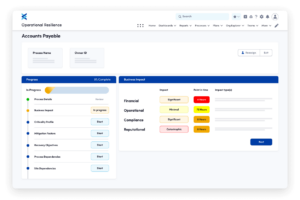
Fusion is an Industry Leader in Business Continuity and Risk Management
Fusion’s purpose-built frameworks and toolsets provide a unified view of your operations, allowing product and service owners, executives, and risk and resilience teams to better monitor risks and look for opportunities to improve or evolve their offerings to meet the changing needs of the market.
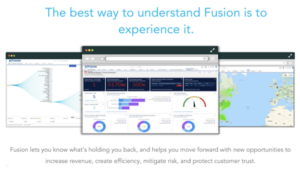
As a leader in the business continuity and risk management software industry, Fusion is known for providing authoritative operational and situational insights together with enterprise workflows to help organizations know what’s holding their team back and move forward with new opportunities to increase revenue, create efficiencies, mitigate risks, and protect customer and stakeholder trust.
Ready to Enhance Your Organizational Resilience?
If your organization is looking to expand on its existing risk and resilience capabilities or wants to learn more about how to meet the new regulatory mandates for running, protecting, changing, and growing your organization, reach out to your Fusion Account Manager or contact us today.
To get started on building your own risk and resilience program, check out this free guide.





